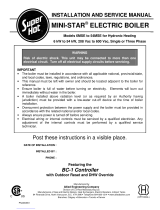
Part No. 550-141-979-0905 2 of 48
This manual must be used in conjunction with the Ultra Oil boiler manual. It is organized into five main sections. They are: 1)
Sequence of Operation, 2) Applications, 3) Installation, 4) Control Settings, and 5) Testing & Troubleshooting. The Sequence of
Operation section has seven sub sections. We recommend reading Section A: General of the Sequence of Operation, as this contains
important information on the overall operation of the control. Then refer to the sub sections that apply to your installation.
The Control Settings section of this manual illustrates the menu screens that are shown on the Remote Display Module (RDM). These
menu settings are referenced to the specific section in the Sequence of Operation.
The Advanced Features Module (AFM) uses a Remote Display Module (RDM) as the method of supplying information. The RDM is
used to setup and monitor the operation of the system. The RDM uses four push buttons (Menu, Item, Up, Down) for selecting and
adjusting settings. As the AFM is programmed, record the settings in the actual settings column of the Adjust Menu. The table is found
in the second half of this manual.
How To Use The Manual
Table of Contents
User Interface .................................................................2
Display, Symbol Description & Definitions ......................3
Sequence of Operation ...................................................4
General ...................................................................4
Boiler Operation ......................................................6
Domestic Hot Water Operation ...............................8
DHW Priority Features ............................................9
Setpoint Operation ................................................ 10
Mixing Operation ................................................... 10
Pump Operation .................................................... 14
Applications .................................................................. 15
Installation ....................................................................30
AFM Contents .......................................................30
Wiring Instructions ................................................30
Cleaning the AFM .........................................................36
Control Settings ............................................................36
DIP Switch Settings ..............................................36
Access Levels .......................................................36
View Menu ............................................................36
Adjust Menu ..........................................................38
Monitor Menu ........................................................ 41
Miscellaneous Menu .............................................43
Testing & Troubleshooting ............................................44
Testing the AFM ....................................................44
Testing the Sensors ..............................................45
Error Messages .....................................................46
Technical Data .............................................................48
User Interface
Menu
All of the items displayed by the RDM are organized into various
menus. These menus are listed on the left hand side of the display
(Menu Field). To select a menu, use the Menu button. By pressing
and releasing the Menu button, the display will advance to the next
available menu. Once a menu is selected, there will be a group of
items that can be viewed within that menu.
Item
The abbreviated name of the selected item will be displayed in the
item field of the RDM. To view the next available item, press and
release the Item button. Once the last available item in a menu has
been reached, pressing and releasing the Item button will return the
display to the first item in the selected menu.
Adjust
To make an adjustment to a setting on the RDM, begin by selecting
the appropriate menu using the Menu button. Then select the desired
item using the Item button. Finally, use the Up and / or Down button to
make the adjustment.
Additional information can be gained by observing the Status field of
the RDM. The status field will indicate which of the AFM’s outputs are
currently active. Most symbols in the status field are only visible when
the View Menu is selected.
Menu Item
Menu Item
Menu Item






















